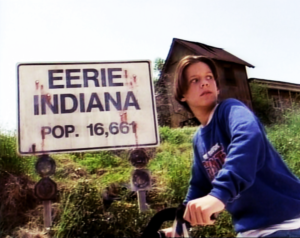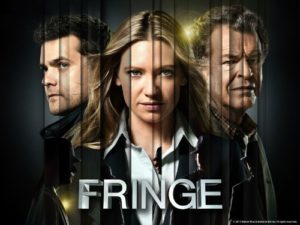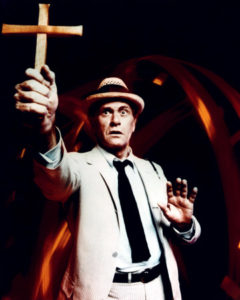It’s October! Always a good month to scare yourself silly (and other people if you can manage it without retaliation. Erm, not that I’m advocating being a bully or anything). If you’re like me, my family, my friends, our uncles, aunts, third cousins, and all the people we passed notes to in first grade, you’ve seen Stranger Things at least twice. It’s amazeballs. Heavy on the ’80s nostalgia, which is why everyone likes it so much. It’s obvious from watching it that E.T., Alien, and Stephen King’s IT and Firestarter are heavy influences, but I kept wondering what else is out there that might have influenced the Duffer Brothers. And maybe I just want something like Stranger Things while I wait for season 2 (due out next summer *crossing fingers!*) and thought I’d share my choices. Please note only one of them is currently available for streaming on Netflix, but the first two are available by DVD.
 Eerie, Indiana (1991-1992). Omri Katz (aka “John Ewing III” of Dallas fame) as teen Marshall Teller chronicled the downright bizarre goings-on in the not-so-squeaky-clean town of Eerie, Indiana. Marshall and his best friend Simon (Justin Shenkarow, the future Matthew Brock on another quirky ‘90s series, Picket Fences) ran into all sorts of spooky, creepy and just plain weird things: ray guns, Bigfoot, Elvis, haunted letters (check out episode 8 for a young Tobey Maguire). Nothing was off limits: in one episode, Marshall got a retainer that allowed him to read dogs’ minds; in another, the friends discovered “The Bureau of Lost,” where all lost things go. It was crazy, it was lighthearted, and Simon and Marshall had a great camaraderie. The series was created by Jose Rivera (The Motorcycle Diaries) and Karl Schaefer (Eureka). Gremlins’ Joe Dante served as creative consultant, which was a big selling point when the series came out. Eerie was cancelled before its last episode could be shown; Disney picked it up in 1993, reran the series, and showed the last episode. There was even a spinoff called Eerie, Indiana: The Other Dimension, a few years later, but I can’t speak to that because I never saw it.
Eerie, Indiana (1991-1992). Omri Katz (aka “John Ewing III” of Dallas fame) as teen Marshall Teller chronicled the downright bizarre goings-on in the not-so-squeaky-clean town of Eerie, Indiana. Marshall and his best friend Simon (Justin Shenkarow, the future Matthew Brock on another quirky ‘90s series, Picket Fences) ran into all sorts of spooky, creepy and just plain weird things: ray guns, Bigfoot, Elvis, haunted letters (check out episode 8 for a young Tobey Maguire). Nothing was off limits: in one episode, Marshall got a retainer that allowed him to read dogs’ minds; in another, the friends discovered “The Bureau of Lost,” where all lost things go. It was crazy, it was lighthearted, and Simon and Marshall had a great camaraderie. The series was created by Jose Rivera (The Motorcycle Diaries) and Karl Schaefer (Eureka). Gremlins’ Joe Dante served as creative consultant, which was a big selling point when the series came out. Eerie was cancelled before its last episode could be shown; Disney picked it up in 1993, reran the series, and showed the last episode. There was even a spinoff called Eerie, Indiana: The Other Dimension, a few years later, but I can’t speak to that because I never saw it.
 Fringe (2008-2013). I can’t believe I just left The X-Files off this list, but I did, because Fringe — which often felt like it was the fictional successor to the X-Files, all aboveboard and everything — tackled a different, more relevant kind of storyline. No, make that storylines. Scratch that. Make that parallel dimensions and file under “travel between.” See also: multiple crossover characters.
Fringe (2008-2013). I can’t believe I just left The X-Files off this list, but I did, because Fringe — which often felt like it was the fictional successor to the X-Files, all aboveboard and everything — tackled a different, more relevant kind of storyline. No, make that storylines. Scratch that. Make that parallel dimensions and file under “travel between.” See also: multiple crossover characters.
The name comes from “fringe” science which explores the paranormal and the unexplainable, such as telepathy, time travel, strange patterns, shapeshifters, ghosts, and, well, parallel dimensions.
The main characters (Anna Torv as FBI agent Olivia Dunham, Joshua Jackson as Peter Bishop, John Noble as Walter Bishop, and Jasika Nicole as Astrid Farnsworth, among many others), were alternately helped or hindered by LSD experiments, mad (but in the case of Walter, ultimately loveable) scientists, government intrigue and evil corporations. Characters garnered hilarious nicknames, such as “Fauxlivia” and “Walternate” as they switched between plotlines set in other dimensions. The characters were always recognizable, but sometimes keeping up with all of the intrigue and the mad science was a little difficult.

Thanks, Walter. Keep in mind, Season 5 is very different from the rest of the series. The showrunners had the green light for thirteen episodes instead of twenty, so they wrapped up the series’s storyline(s) in a very unusual but necessary way. Fringe was fun, it was dark, sometimes it didn’t make sense, but it was totally enjoyable, and the well-bonded cast was one of the strengths of the show. Look for Leonard Nimoy as Walter’s onetime science partner.
 Kolchak: The Night Stalker (1974-1975). Another one-season wonder that garnered a cult following after it was syndicated for television in the 1980s. Darren McGavin played Carl Kolchak, an investigative reporter who couldn’t help looking into mysterious crimes. Kolchak was introduced in a TV movie written by science fiction legend Richard Matheson. The series covered Kolchak’s exploits tracking down Jack the Ripper, vampires, swamp monsters, lizard-men and Aztec cults. The lizard-man episode frightened me for weeks, and so too did an episode that featured store mannequins animated by a witch. The one that stays with me some forty years later is “Horror in the Heights,” in which a rakshasa, or Hindu demon, approached its victim by taking the form of someone the victim loved best — and hugging them while it consumed their flesh. From the front, the viewer saw the victim’s loved one; from the back, the viewer watched as a hairy monster preyed on the victim. The series action and some of its sentiments are a little dated now, but it has some of the spookiest episodes and one of the pluckiest reporters ever to grace television. Darren McGavin was the only person who could have played Carl Kolchak. When he defeats the rakshasa by shooting it with blessed crossbow bolts, he tucks the remaining arrows inside his sportcoat just as if they were a handkerchief or his reporter’s notebook.
Kolchak: The Night Stalker (1974-1975). Another one-season wonder that garnered a cult following after it was syndicated for television in the 1980s. Darren McGavin played Carl Kolchak, an investigative reporter who couldn’t help looking into mysterious crimes. Kolchak was introduced in a TV movie written by science fiction legend Richard Matheson. The series covered Kolchak’s exploits tracking down Jack the Ripper, vampires, swamp monsters, lizard-men and Aztec cults. The lizard-man episode frightened me for weeks, and so too did an episode that featured store mannequins animated by a witch. The one that stays with me some forty years later is “Horror in the Heights,” in which a rakshasa, or Hindu demon, approached its victim by taking the form of someone the victim loved best — and hugging them while it consumed their flesh. From the front, the viewer saw the victim’s loved one; from the back, the viewer watched as a hairy monster preyed on the victim. The series action and some of its sentiments are a little dated now, but it has some of the spookiest episodes and one of the pluckiest reporters ever to grace television. Darren McGavin was the only person who could have played Carl Kolchak. When he defeats the rakshasa by shooting it with blessed crossbow bolts, he tucks the remaining arrows inside his sportcoat just as if they were a handkerchief or his reporter’s notebook.
Honorable Mention: Wayward Pines, also produced by The Duffer Brothers, but I haven’t seen it yet. Guess what I’m going to go do?

Woot woot to FRINGE! I miss this show, and should really sit down for a rewatch one day!